Saturday, 25 June 22
Cuxhaven
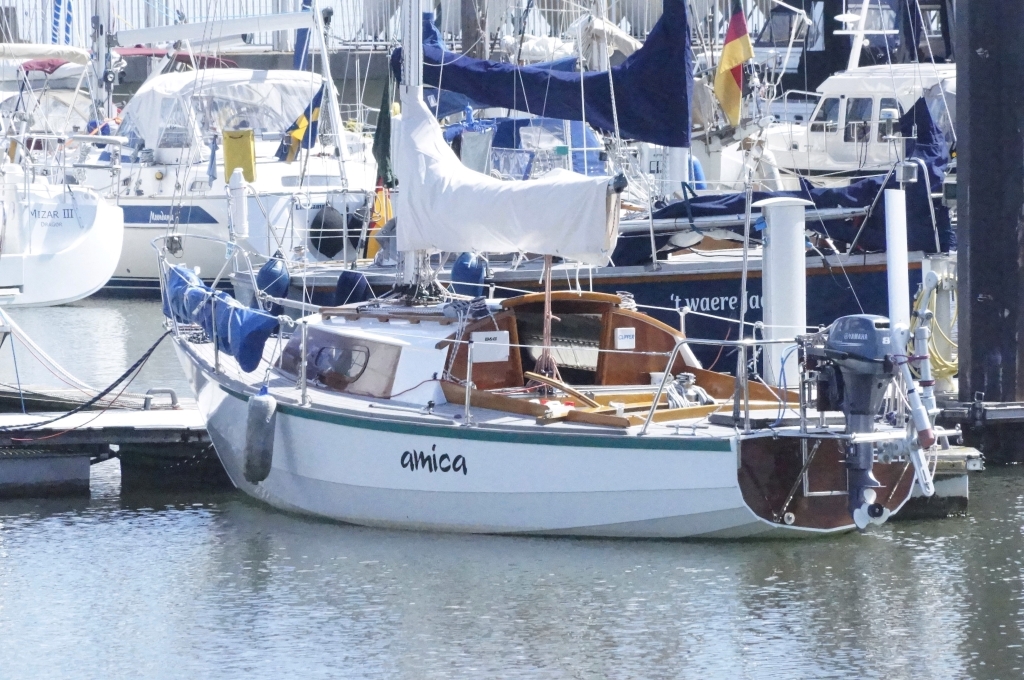
amica in Cuxhaven
Finally, I taste and smell the sea air again here in Cuxhaven. I let the first 45 nautical miles from Wedel to here sink in. For me it’s a big step to leave one world behind and dive into another for a long period of time.
The last few days in Hamburg were not only stressful, but also quite stressful in terms of temperatures, close to 30 degrees and pure sunshine packed on top of that. So, I let Thursday pass as the actual day of departure and didn’t set off until Friday.
The break in Cuxhaven had been planned for a long time, so it didn’t matter if the showers came down, if it was raining all day or if the wind was blowing from the wrong direction. I covered the distance Wedel – Cuxhaven under motor, with a stopover in Glückstadt. Both days, there was zero wind, but fortunately, a few clouds, that provided shade at the still 26 degrees. I still need that.
Barbara is visiting; she also needs a few days of sea air. I plan to leave very early on Thursday with Norderney as my destination. Until then, the main thing is to relax and prepare mentally, to get away from the hustle and bustle of life.
Norderney
Friday, 1 July 22
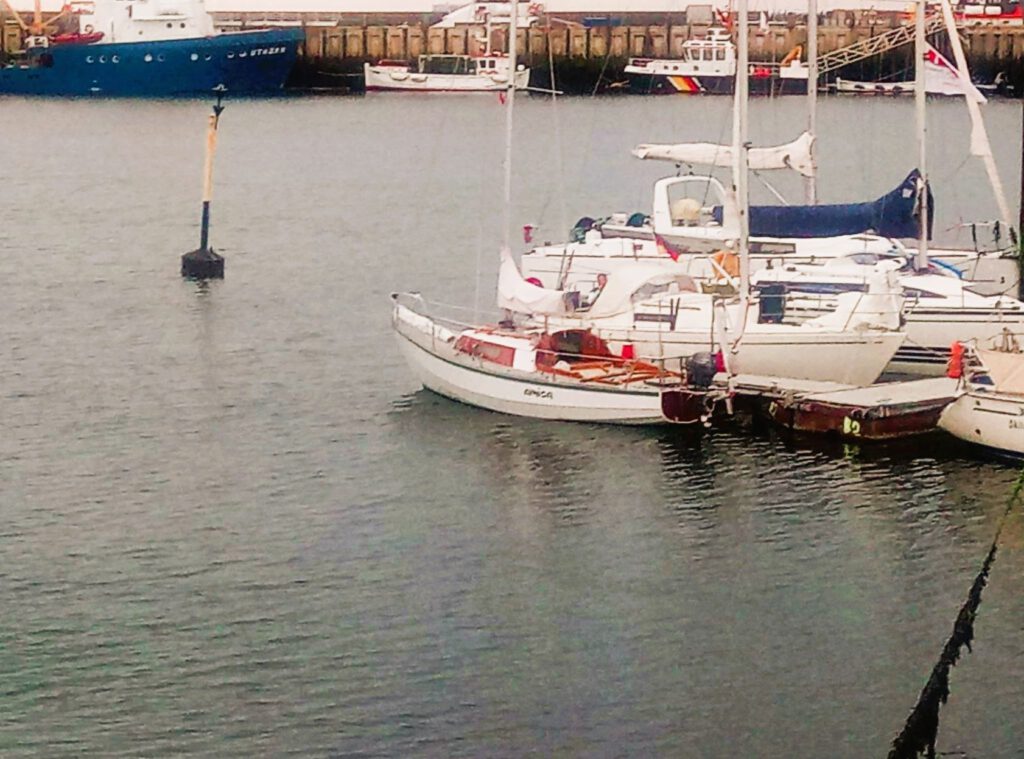
amica on Helgoland
Those were two very exhausting trips (Wednesday to Helgoland, Thursday to Norderney), but it’s a good thing I decided to split via Helgoland. This makes the journey longer, but the daily hours underway shorter. Two days in the pure sun are still too much for me. How fitting that today is first a stormy day, with rain and temperatures around 20 degrees.
The North Sea is full, not so much with moving ships, but a large number of anchored vessels such as large container ships and feeders. Steering a straight course becomes child’s play, always from one mooring to the next.
I took the precaution of sailing under motor across the Dovetief to Norderney, as this approach was still unknown to me. However, even 2 hours before low tide, there is always a water depth of 3.5 to 5 m along the red buoys.
Now I have to think about how I’ll get to Lauwersoog when the westerly winds persist, because unfortunately it’s not possible to go through the Eemskanal. There is a damaged bridge before Groningen and does not open for sailing boots.
Harlingen
Wednesday, 6 July 22
Here in Harlingen it is stormy weather and tomorrow it’s supposed to be even 7 Beaufort. I have booked in with the HWSV until Friday. Nevertheless, it’s nice that I’ve already made it this far. My sleep is increasing, so I’ve finally arrived at the relaxation phase. So far, the tour has been very exhausting after all.
Riding through from Norderney to Lauwersoog was my plan A. Plan B and C (something with Borkum) are no longer of interest. After a day’s rest on Norderney, I was ready for this distance, 56 nautical miles.
The route via Groningen closed due to a defective bridge. And so, I liked to take advantage of the only weather window on Saturday 2 July, even if it was only half a window. Rising water until about 2 p.m. near Borkum, wind SSW 5 with gusts, decreasing, from 2 p.m. rapidly decreasing to O wind force, low water at the Westgat at about 7 p.m. Exactly, that happened. There was no chance for sailing, because you can’t cross in the Medem fairway south of Juist. Unfortunately, yesterday’s sea was still rolling from W and NW, which was unpleasantly noticeable on the Borkumriff, the Ems and the Hubertgat. A long time I haven’t had so much rocking in.
Although I only docked in Lauwersoog at 9.30 p.m., I leave for the lock again at 8 a.m. the next day, because it’s not so nice in this fishing harbour. Already at 12 o’clock, I was in Dokkum and allowed myself a day’s break.
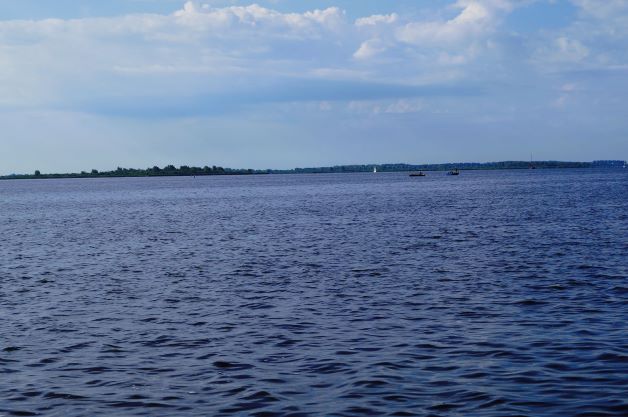
Lauwersmeer in the mornung
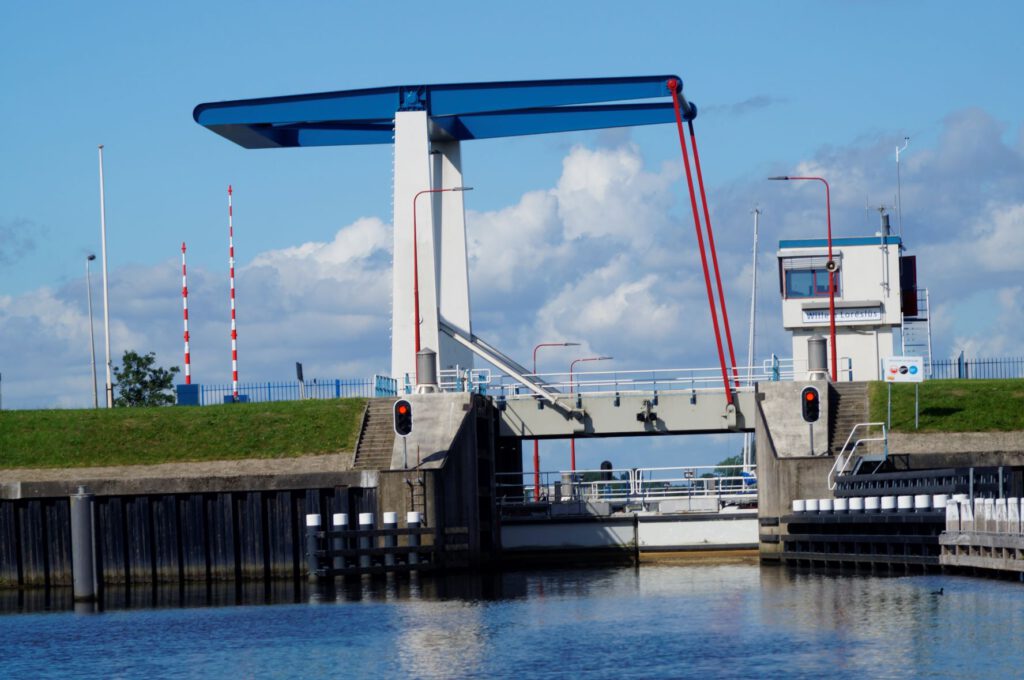
Lock to the Dokkumer Ee
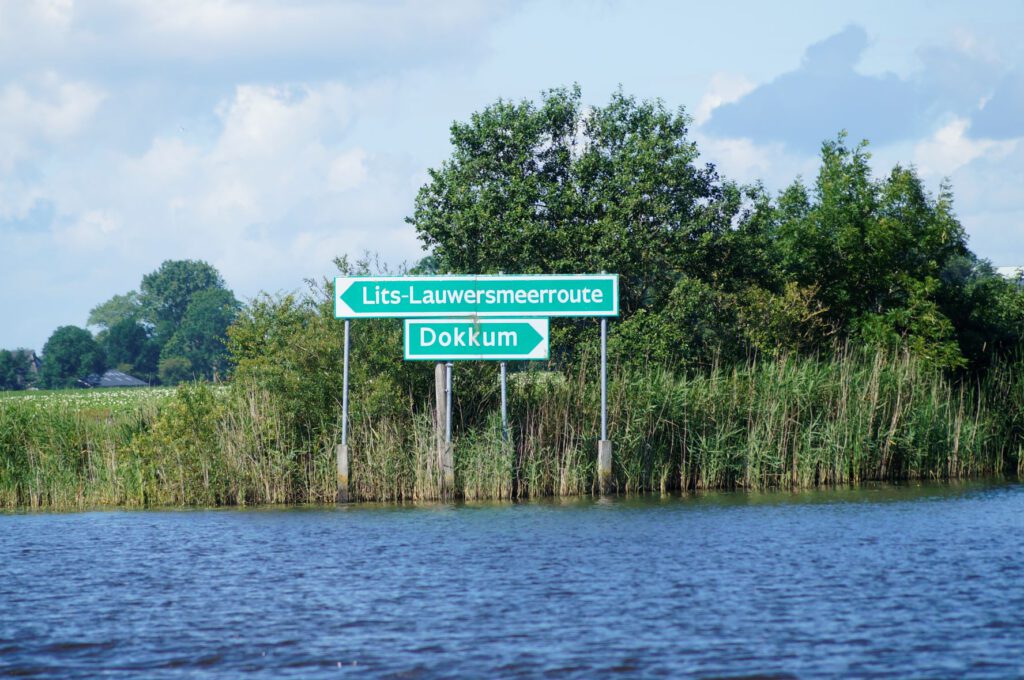
You can’t get lost here
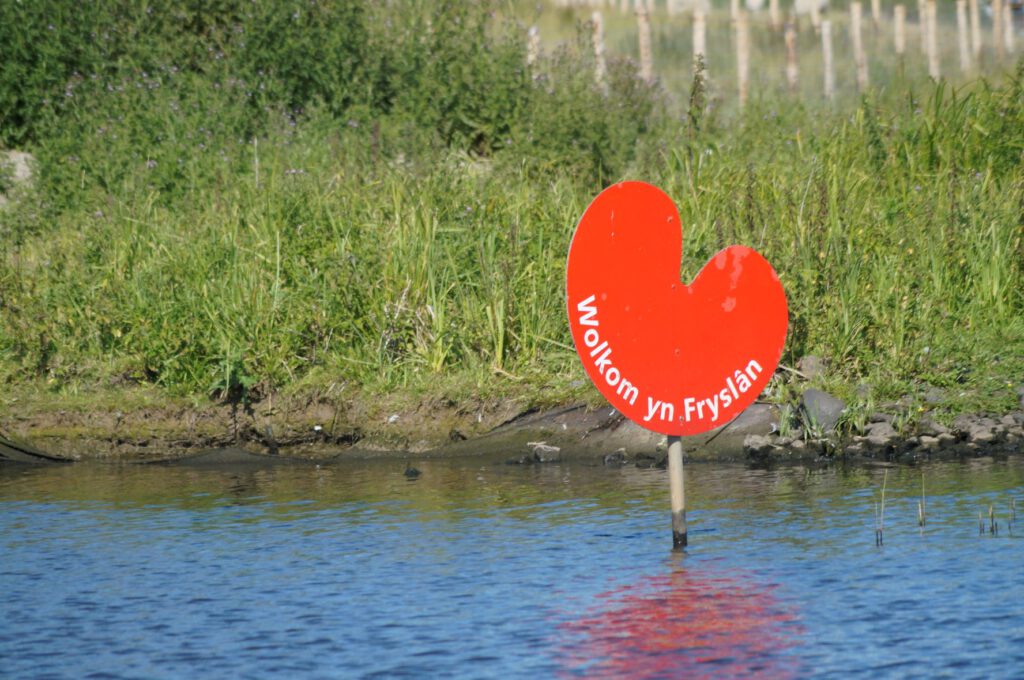
Where are we?
On Tuesday, I continued to Harlingen. The canal trip to Leeuwarden went smoothly, but in the Van Harinxmakanaal to Harlingen, where all the bridges are remote-controlled, it sometimes took a long time for opening. I guess they don’t look at their screens all the time. At the last bridge, I even had to take a radio call for someone to press the corresponding button. Then it didn’t take a minute, and I was through. That’s really annoying.
Blankenberge , Belgium
Wednesday, 14 July 22
And now already in Belgium, two weeks after Cuxhaven. That’s right on schedule and helps to get south quickly. Now the right wind conditions are coming, often something with north or east.
After 3 days in Harlingen, I decided to go inland, the prospects on the coast are too unclear. The route led via Kornwerderzand, Enkhuizen, Ijmond, Gouda, Willemstad, Middelburg to Blankenberge.
There are also many construction sites in the Netherlands, for example the Afsluitdijk at the Ijsselmeer is being raised, which made the passing through at Kornwerderzand considerably longer. With waiting times, the whole thing took over 2 hours, otherwise you’re through in 30 minutes.
Waiting in front of the lock
On the other hand, I was able to sail south on the IJsselmeer and the Markermeer in good 4-5 Bft. There was also some sea here, and I was glad not to have to wait on the coast in onshore 5 Bft for better conditions, the wave height out there was given as almost one metre.
Sailing on the IJsselmeer
Paand van Marken
Shortly after that, it was over with sailing, we went into the Nordzeekanaal. What struck me was that everyone was sailing north. It was the weekend, and maybe they all wanted to go to the islands. My direction is obviously not so popular, but there is one exception: Amsterdam is also worth a trip. There was a big crowd in front of and in the lock to Amsterdam. Some were even turned away. In the Nordzeekanaal to the west, again, I was alone, and once more, I felt the strong breeze from the west. The overnight stay took place in Ijmond, a harbour in the middle of nature, with planes taking off from Schiphol. They only take a break between midnight and 4.30 am. A restless and short night.
The canal trip means waiting in front of the bridges. The passage through Harleem took 1.5 hours. Oh yes, here you can now also pay by app, there’s a big QR code for that on the bridges. I learned from Scheveningen that you can only pay with the Bluewater app, and the harbour master there is happy to explain how it works. But by him, you can’t pay the harbour dues and if you leave the harbour towards land, you can’t get back to the boat. There are supposed to be people who give such harbours a wide berth.
Harleem
Passage through Alphen aan den Rijn
One of the big lifting bridges between Alphen aan den Rijn and Gouda
After the railway bridge at Kaag, the opening of bridges was swift. So I quickly got to Gouda to the mosquitoes. From here on, the mosquitoes annoyed me until the end of the Staande Mastroute near Vlissingen. They hid on board during the day and came out at night. The last one didn’t leave amica until Blankenberge.
Then the lock in Vlissingen, which I don’t like and which probably doesn’t like me either. The lock manoeuvre went totally wrong this time, with damage to my wind pilot. Still, far too often, I make the mistake of orienting myself to others, only to realize when I moor up that, hey, I’m on my own. I don’t have anyone to keep the boat off or put out a line. As a single-handed sailor, I have to manoeuvre according to my own considerations and to keep distance from others. If necessary, I have to be the last to enter the lock, even if others are kind enough to let me drive first. In particular, I should not moor behind commercial vessels, which steam into the jumping leash. No one can master the screw water. Sometimes you should refuse help, even if it is meant nicely. Hardly any sailor can judge how it is as a single-handed sailor. So please just leave it alone and only provide requested support, it works better that way.
On the way to Blankenberge upon the North Sea, the sea relaxed me again, beautiful downwind sailing reach with lots of space on the water. With this inner calm, mooring works out excellently, and two more helping hands are then welcome. I had understanding neighbours who didn’t find my crash in the lock so tragic. They helped me find damages at the windpilot, as they had one themselves, also knew Peter “Forthman”.
Le Havre
Sunday, 24 July 22
10 days in the endless sea, without bridges, locks or sills, always in freely accessible harbours. I had 5 port days and was underway for 5 days. With the distance covered, I am very satisfied. It started with a wonderful sailing trip from Blankenberge to Dunkerque. First, there was a light breeze from the north, which later became unsteady and stronger. However, that was no problem, just a little work, reef in, reef out, or the mainsail down and up again.
Relaxing while sailing
But now I finally have to take care of the current here, while I have everything on board, the Bloc Marine, numerous apps like “meteo consult marine” or “maree france”. Because, as I remember my last trips in this area, high tide (PM=pleine mer) and low tide (BM=basse mer) don’t say much about the direction of the current. Then there are the coeffs, which you can read from tables for numerous harbours. They tell you something about water levels, which here influenced more by the moon, hardly or not at all by wind directions.
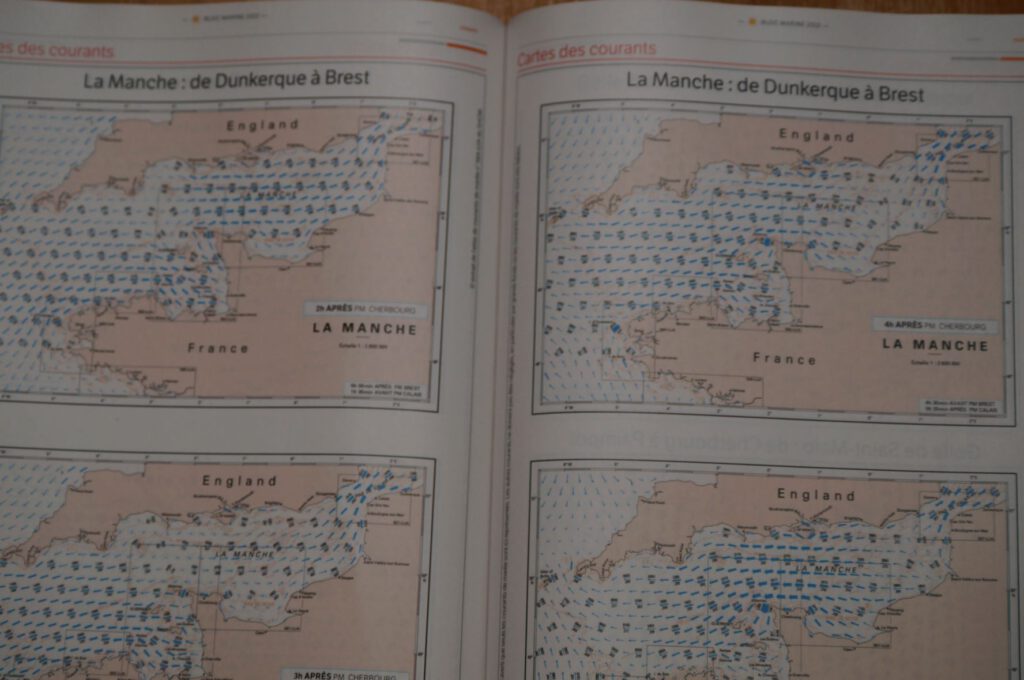
Tables with directions of current
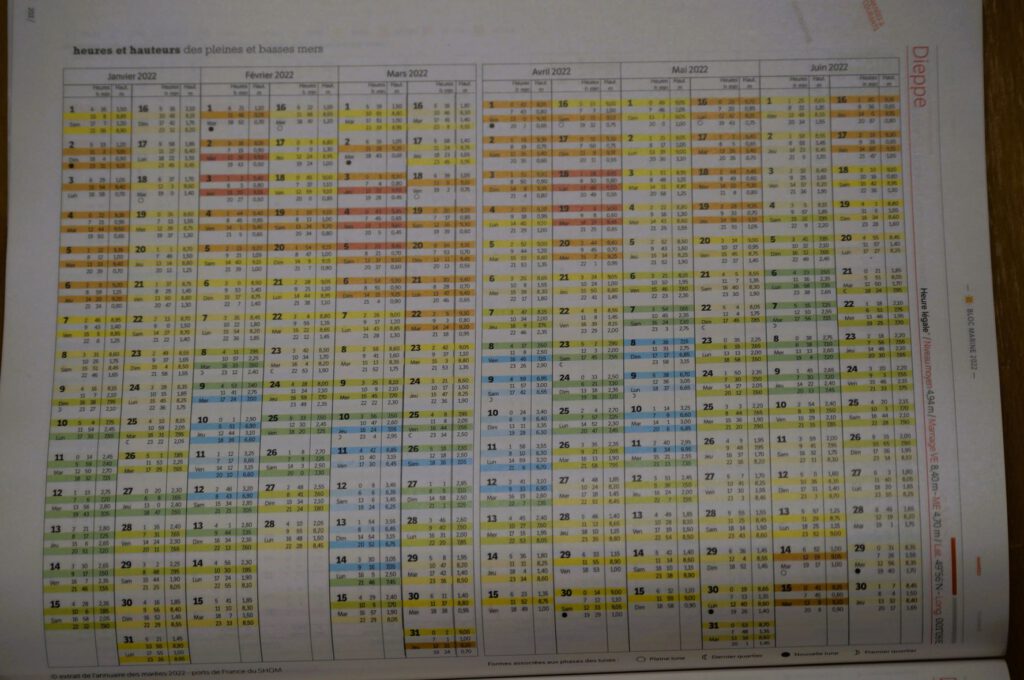
Coeffs (Coefficients de mareé)
Because I didn’t look at these tables, I was punished with counter currents until Nieuwpoort, only then I sailed with the current. That was also the reason I decided to sail on from Nieuwpoort to Dunkerque, now it should go fast.
After a day’s break in Dunkerque, the same game again, but this time after good planning. With the current, I was fast towards Calais. There I would have had to wait another 1.5 hours for the porte to open for the marina. So why not sail the remaining 2 hours at 8 knots over ground to the tip of Cap Griz Nes. However, I had to keep the outboard running, as the time the change of the currant direction was to happen exactly at the Cap.
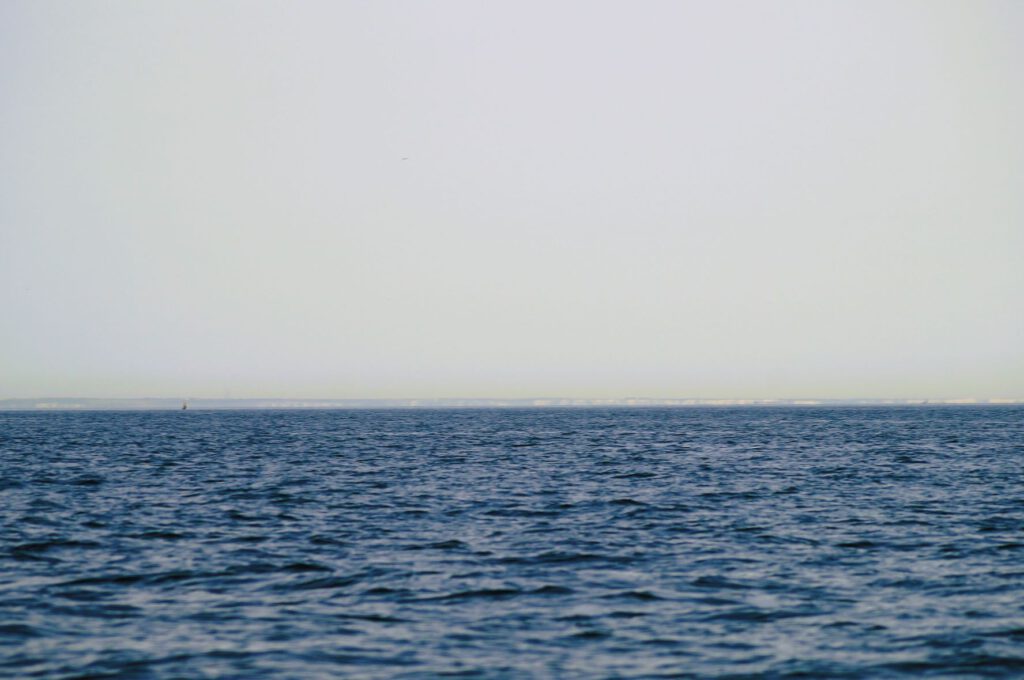
The white cliffs of Dover, the eyes see more
A bit annoying, but 15 minutes earlier, and I could have circumnavigated the cape in peace. Since there is no slack here, the counter current set in with all its force right at the tip. In addition, the wind freshened to north at 5 Bft. Hello, this was a current sea. Now it was just a matter of steering the boat straight through, not cross steering. It worked, and I sailed the remaining 8 nautical miles with this fresh breeze quickly to Boulogne sur Mer.
Two days’ break with a sound system from an open-air event directly on the quay was not relaxing, especially as I could hear unfortunately only the bass at low tide, 8 m below the edge of the quay. Amica was vibrating. But I had to wait for the right wind, south-west doesn’t work at all. The plan was as follows: 1 hour against the rest of the current, then 5.5 hours with it, and then against it again. There’s no other way at 54 see miles. It worked well, only the wind didn’t really play along. After 3 hours, I had to use the outboard. Towards the end, there was no wind at all.
I can see Dungeness over there, unfortunately you can’t.
Nice sailing, the wind should only hold out once.
In Dieppe I weathered the hot days with up to 41 degrees. How to do that? Of course, sun protection under the tarpaulin is important, and then I refreshed myself every hour with water (unfortunately it was no longer cold). In the evening, the temperatures dropped almost 20 degrees, and I was freezing. I wonder how one can survive such extreme weather in the future. Yes, climate change will keep us busy for a long time to come. There were 600 deaths in France and over 1000 in Portugal because of it.
After three days, I set off for Fecamp, always keeping an eye on the current. Unfortunately, the wind and the waves didn’t play along. 31 nautical miles to Fecamp, it’s impossible to tack against the wind at 2 Bft, especially as this stupid wave slows you down. Nevertheless, At least, I tried twice to sail one long stroke. As a result, I was forced to drive under engine against the current for the last hour. No, it just doesn’t work that way.
The eternally long coast.
Ah, here comes the Port entry to Fecamp/View of the entrance pier/And now in there, once under 2 metres depth A day’s break in Fecamp because of thunderstorms, but at least they passed here. I like to sail the 21 nautical miles to Le Havre! I’m going to sail up to Cap Antifer with current acceleration as far as I am across the Antifer oil harbour exit. Then a nice course to Le Havre. Especially great, the sun hidden in the clouds most of the time.
Small waves at 5 knots
Now I’m taking another long break here in Le Havre, as I always do when I’m here. I wait for better weather conditions.
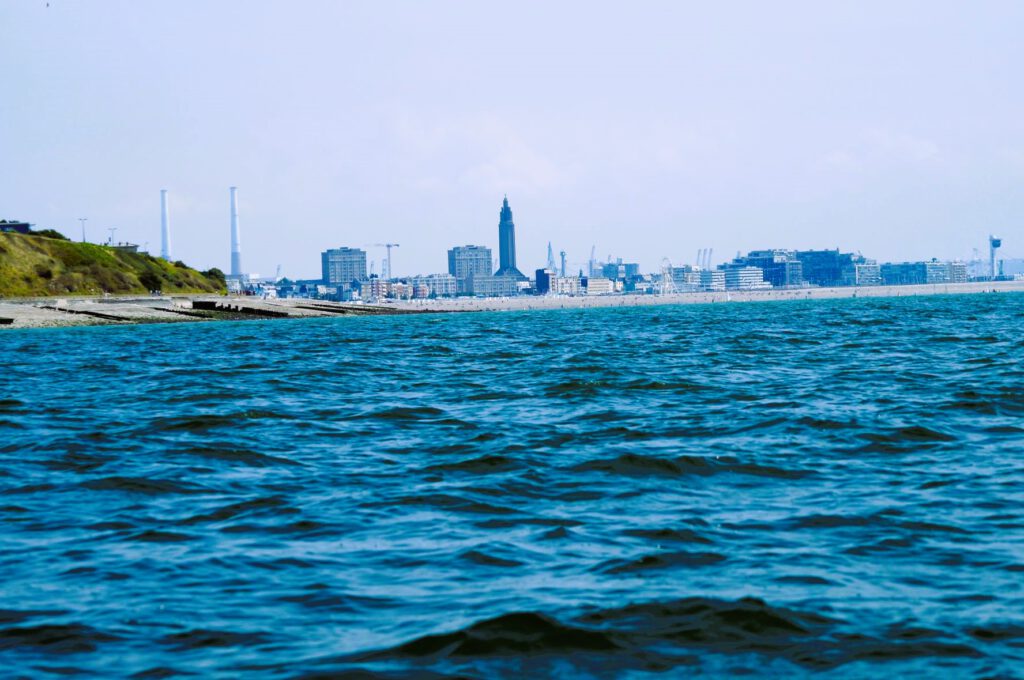
Le Havre!
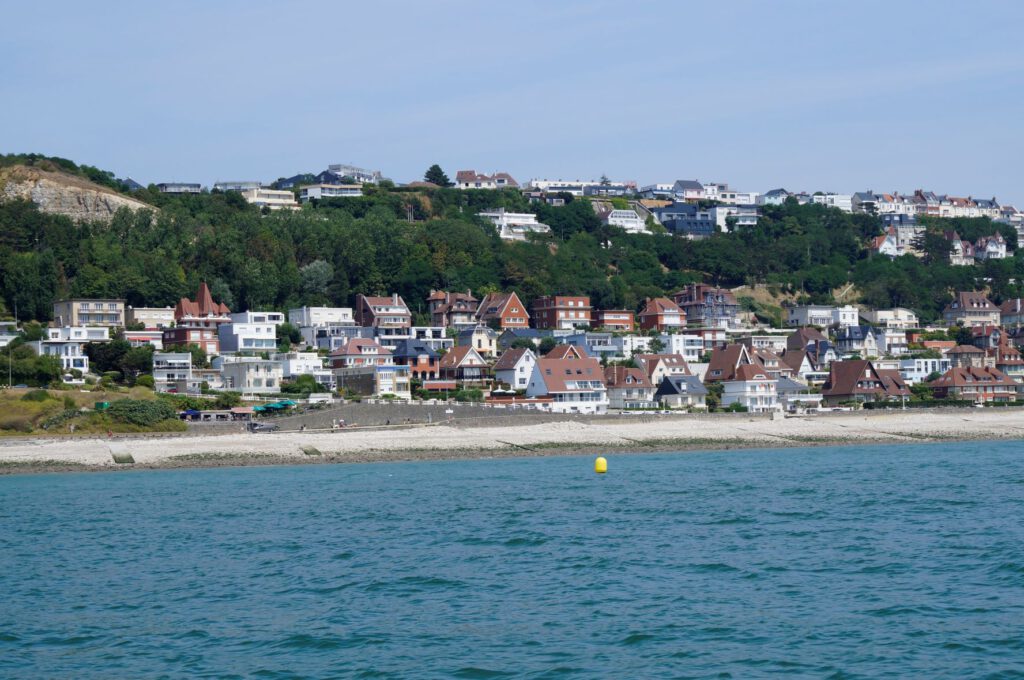
There are other corners of Le Havre
During this 3-day break, I realized that I’ve spent most of my time sailing and going forward. I haven’t yet arrived in the country, as you might call it. At land, I’ve only been interested in the routes to the shops so far. Maybe that has something to do with the fact that I’ve already been here several times. I’m also busy carrying out the remaining work on the boat, especially setting up the wind pilot correctly for the next trips after the repairs. Nevertheless, I can’t go on like this, there’s always something to discover on land.
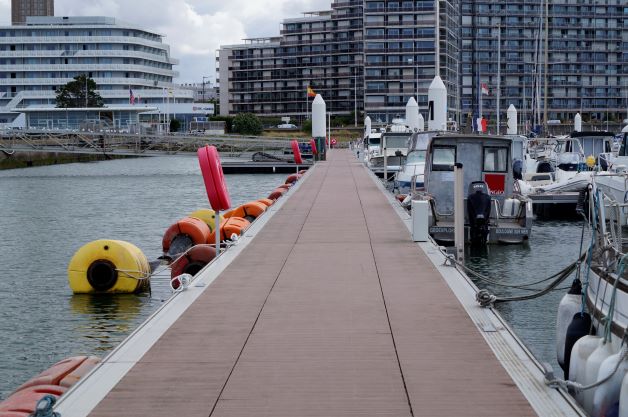
The longest paths are the ones on the jetty
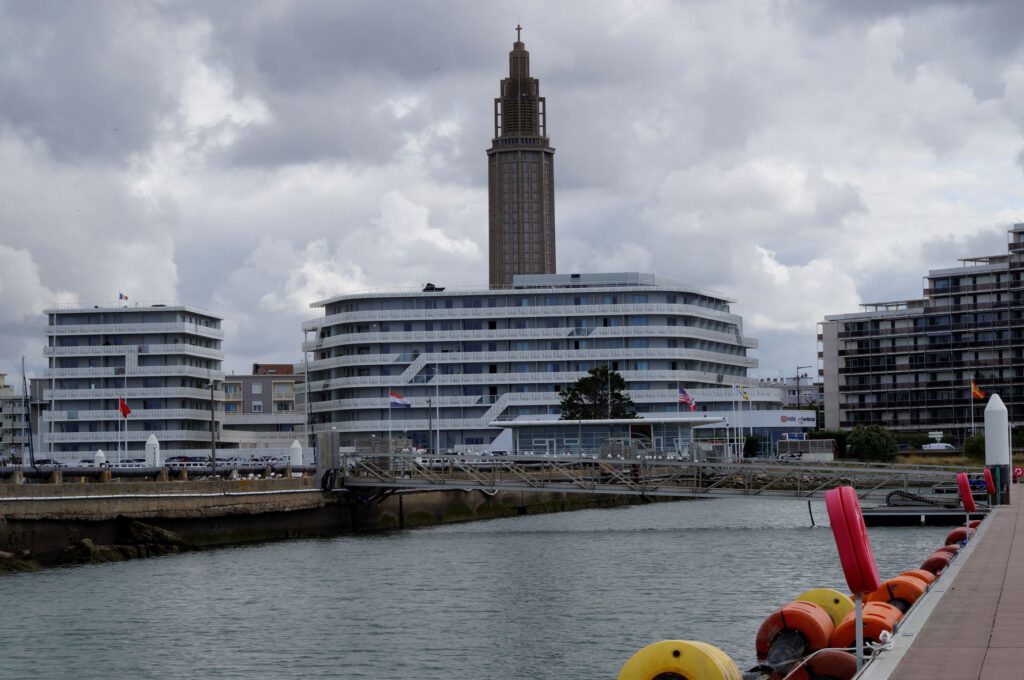
New hotel with structural adaptations to the local architecture — the balustrades
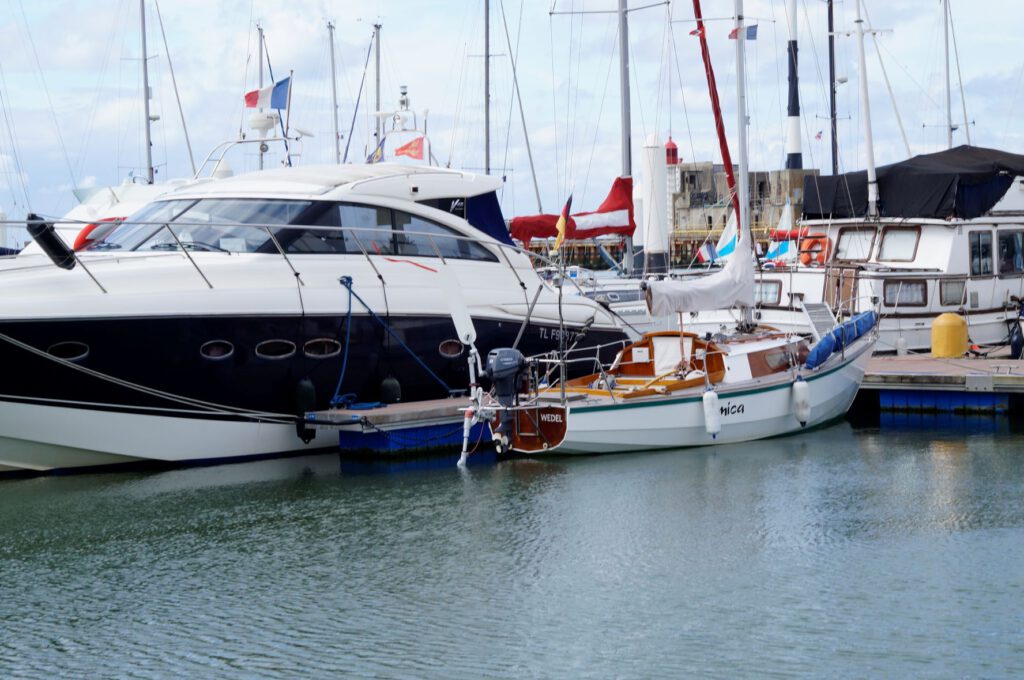
Small amica
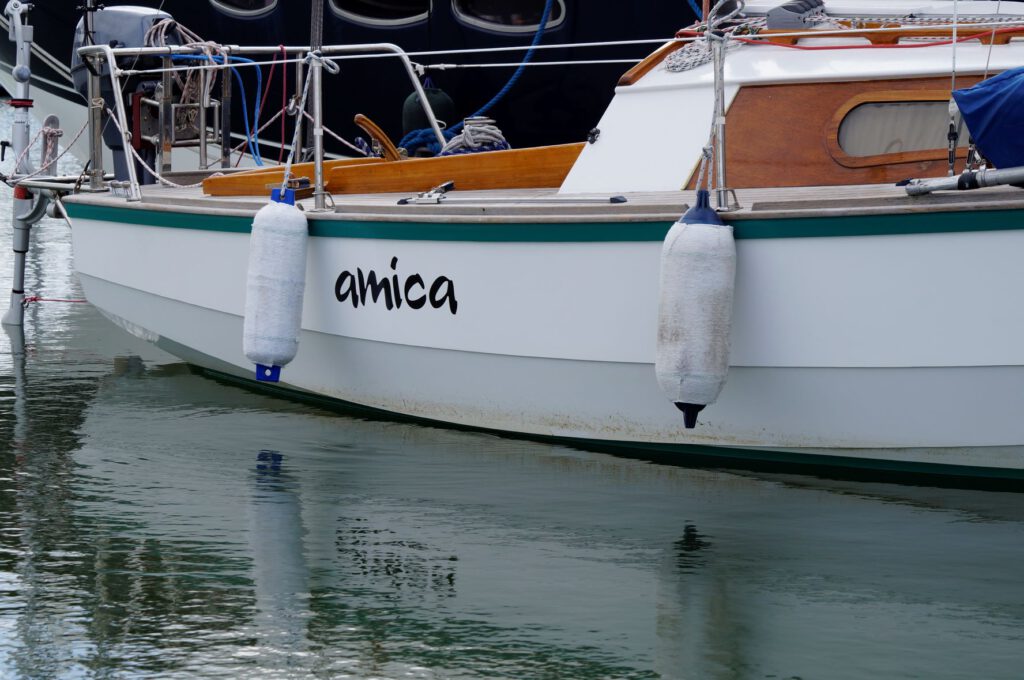
With a dirty edge. No harbours in Normandy have clean water, so cleaning doesn’t help much.
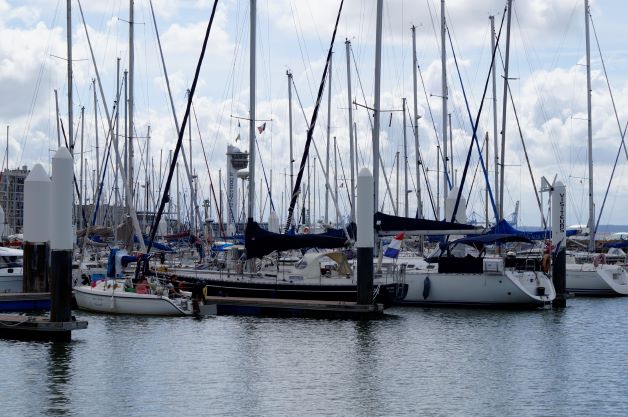
Even smaller boat
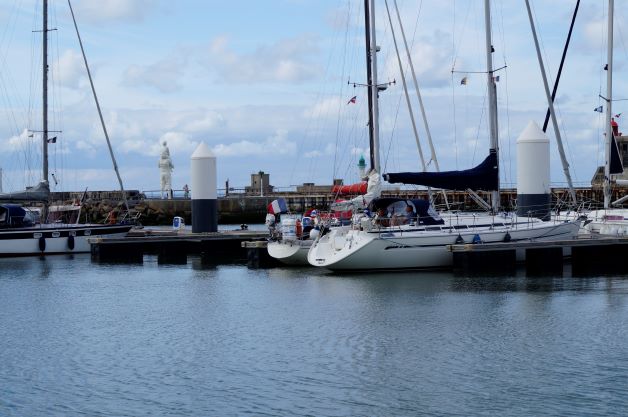
Empty harbour
Thursday, 28 July 22
Cherbourg
After three days in Le Havre, I was sufficiently rested to set off on the long trip to Saint-Vaast-la-Hougue. There was no wind for the first two hours, later a nice breeze from the north set in. Of course, I had to ask my colleague the wind pilot to do his job for once. And he did a great job. Not only was I able to have a coffee in peace, but I also had time for lots of other things, such as filming clips.
It works perfectly
The most beautiful perspective
This is how the water rushes by
Saint-Vaast-la-Hougue is actually a very nice place to stay. I would love to visit Tatihou Island one day. All I have in mind is to take advantage of the favourable weather conditions. I go in the harbour in the evening, buy a baguette in the morning, have breakfast and set off again straight away.
Unfortunately, a light breeze from the east calms down just before the tip of Pointe de Barfleur. Then there was the widely visible edge with breaking waves. A Swedish yacht wanted to break away from it and headed east until they realized that there was no sandbank at a depth of more than 30 metres. I was amazed to find a raz in this shape here. Fortunately, I was able to start the outboard motor in time. I didn’t want to just drift through, I needed rudder pressure to be able to steer.
Although this Pointe de Barfleur is described as dangereux in the Marine blog, I couldn’t imagine breaking waves 1 metre high with a maximum current of only 4 knots. Breaking waves, no this is not a wind sea; the waves were short, steep and ran crosswise. In England this is called overfalls, unfortunately, we don’t have a German translation for it, we don’t know anything like it. And I didn’t have a camera to hand.
This is not my home territory to be able to describe these phenomena correctly. I think that when two or more large masses of water from different directions meet, there is a lot of turbulence. Whirlpools and accelerations created in the water, eddies and races, as they called in English. Four years ago, I travelled with the current to the east, when it was a bit choppy here, but otherwise there was only calm and fast-flowing water. In this direction, two masses of water don’t meet, but simply divide according to the peak.
If this is case, I hope to encounter relatively calm water at Cap-la-Hague. I’ll be coming with the current from the east, and the water masses will have to divide into three directions at the tip: west, south-west and south-south-east. I wonder if my theory is correct.
